Anker Stones
Last update: 9/5,2024
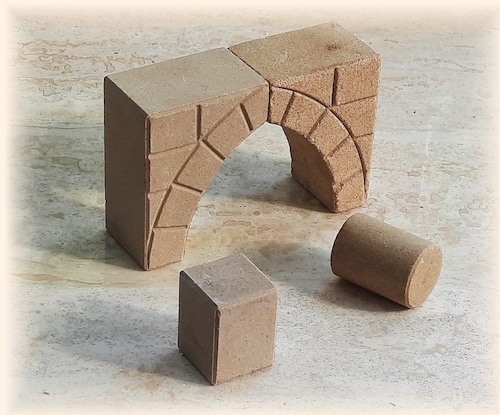
The history of Anker Stones
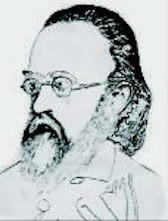
The birth of miniature building bricks, later called 'Ankerstones', took place in 1863 when the pedagogue Jan Daniel Georgens (1823 - 1886), a pupil of Friedrich Fröbel, marketed brick-building boxes developed by him. The stones were cast from a kind of cement. Sample books appeared with stone shapes such as the cube and an elongated stone. 10 years later, these were already extended to (Romanesque) arches, roof stones and spires.
In 1878, Gustav and Otto Lilienthal developed a greatly improved recipe. The stones were now made from a mixture of silver sand, chalk and raw linseed oil and then pressed together in a mould of the right shape. The stones are then 'baked' for several hours at a temperature of 150 - 200 ºC, causing the linseed oil to harden by polymerisation. With the colours sandstone yellow, brick red and slate grey, the look and feel of real natural or brick is achieved.
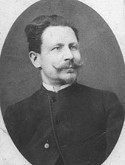
Forced by poor sales, Gustav Lilienthal sold the manufacturing tools of the Georgens building sets including the patents in 1882 to shrewd businessman Friedrich A. Richter, who had already built up an empire in Rudolstadt (Thuringia) with the production of medicine. - Later, Lilienthal was nevertheless granted permission by Richter to continue brick sales on a limited scale -. The name 'Anker' was introduced by Richter. The system of 'Anker' construction boxes grew into an intricate set of some 400 boxes of different series and was very popular around 1900, despite its high price.
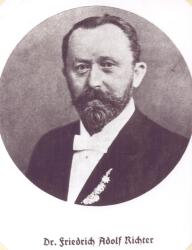
The small boxes with not much more than a hundred bricks and a limited number
of brick shapes were intended for children, but by buying larger and larger supplementary
boxes, through 14 intermediate stages you reached a collection of more than 3,800 bricks
with hundreds of different brick shapes. Obviously, the large buildings you could make with
these were only suitable for adults with good motor skills.
After its heyday in the Belle Epoque, stone production was gradually scaled back from 1910 onwards. Apart from the Neue Folge (NF) series, many other somewhat smaller series were produced, such as VE, DS, Neue Reihe, Burgenbau and the bridge-building boxes. The final end came after World War II, when Rudolstadt became part of the GDR.
After the reunion in 1989, production of Anker bricks was restarted by trial and error. Currently, all NF boxes are again for sale at Ankerstein GmbH, still in Rudolstadt.
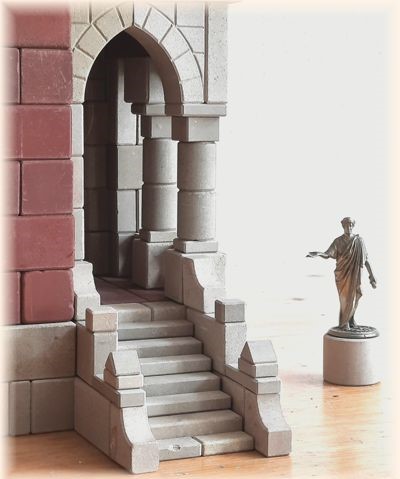
Building with Anker Stones
The dimensions of the most commonly used bricks are derived from a unit of 25 mm. There is a cube measuring 25 x 25 x 25 mm, but also a stone measuring 50 x 25 x 25 mm, 12.5 x 25 x 25 mm and 37.5 x 12.5 x 6.25 mm. So you can come up with large numbers of different stone shapes. Many of these have actually been realised.
Apart from block-shaped bricks, Romanesque and Gothic arches come in various sizes, cylinders to make columns with, triangular blue bricks for roofs and special bricks for spires. Many arches are split into two parts, allowing you to use them for other, ornamental purposes as well. In total, several hundred different stone shapes were produced. In the CvA catalogue , updated to 2013, you can find them all.
The bricks are not glued but stacked loosely on top of each other. This works well because they are heavy and rough so that a building does not collapse at an unexpected touch, but loses at most a stone. To give you an idea, a sizeable Anker building of over 3,000 stones is often 70 - 100 cm high and weighs more than 50 kg.
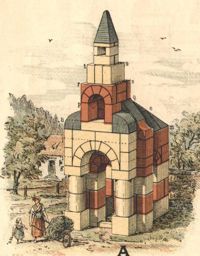
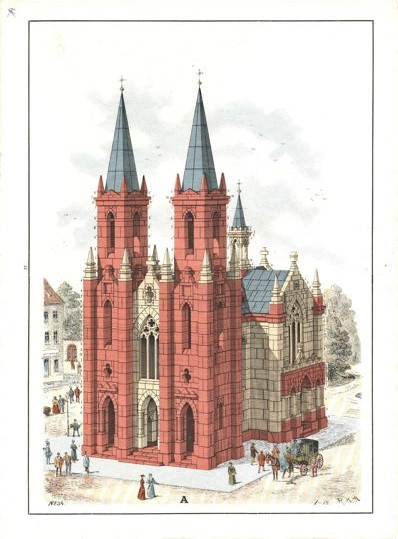
Building examples
Now you also want to do something with those Anker stones. After stacking some stones on top of each other, you notice as an adult that it is not so easy to turn them into a building that also looks a bit attractive. For this NF beginner's box and the 14 subsequent stages, the factory had hundreds of building examples made by architects for villas, churches, castles, town halls and other public buildings, as well as pavilions, coach houses, ... Many designs were also made for other building box series such as bridges. The buildings were usually designed in one of the common neo-styles of around 1900 such as neo-Gothicism and neo-classicism.
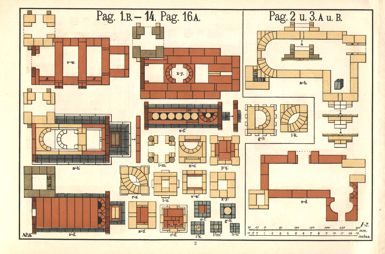
Now, with the somewhat larger buildings, you can no longer see which stone is in a particular place. For this reason, even the small NF6 buildings sometimes required several sections to be drawn in order to figure this out. The really big buildings like NF34 therefore required dozens of sections.
You can find that vast amount of building examples and everything else Richter's Ankerfabriek produced at Ankerstein.ch and Ankerstein center.
Metal in Anker
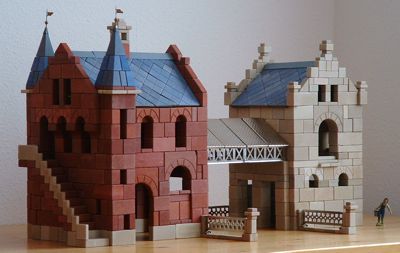
Lilienthal had long been unhappy with the roof construction of his stone-built boxes. In 1887, he wrote to his fiancée Anna Rothe about his idea of equipping the boxes with "roofs of galvanised tin plates, supported by wooden rafters, so that the roof becomes really hollow and not a solid lump of stone like Richter's". The ensuing legal battle over stone production with Richter meant that nothing came of that idea, but Richter was already developing it. In 1901, with the Bridge Building (Br) series, metal was also introduced as a building and construction material. Initially only for bridges, but with a primitive possibility of using the bridge decks as roof plates as well. The latter idea was further developed in the new construction box line the VE (Vernickeltes Eisen) series for which a whole new line of new building examples was developed parallel to the NF series. With these, all kinds of buildings as well as bridges could be built.
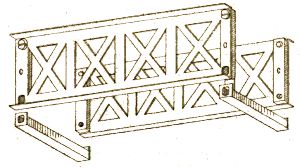
Br and VE series nickel-plated bridges were ingeniously constructed, but required many small, often special parts that could all get lost. However, you could also make a roof with the nickel-plated bridge decks and a few special attachments. These roofs did still have problems with stability and looked a bit tinny. They therefore never really became a success.

With the DS(Dach Steine) series, introduced in 1909, the number of bridge parts, now lacquered instead of nickel-plated, was significantly reduced. This made them easier to use, but lacked the refinement of the nickel-plated parts.
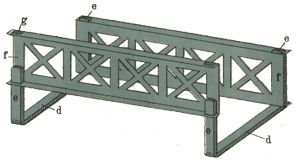
But more successful were the DS roofs of painted thin iron sheets. These were
covered with flat roof tiles, so they far surpassed the solid-brick roofs of the NF series
in aesthetics. Stability was also better, although then it was still not quite equal to that
of the solid-brick roofs of the NF series. Only after 1990, with the introduction of a small
component, a 2-mm adjusting ring
 , did the stability
of the DS roofs become equivalent to that of the NF roofs.
, did the stability
of the DS roofs become equivalent to that of the NF roofs.

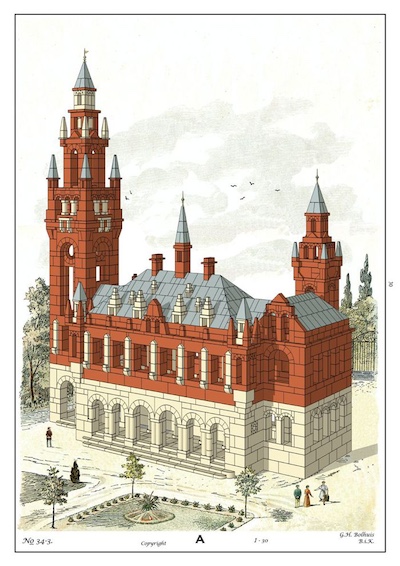
New designs
After the Anker Factory's activities were increasingly scaled back after 1910, owners of larger brick collections also started making their own designs. Especially during and just after the Second World War, some designers like Wyttenbach and Bolhuis made a name for themselves in this, especially the NF series. And in the nineties of the twentieth century, when the Anker factory started to release higher and higher NF continuation boxes, some talented people among the Anker friends threw themselves into this activity. Apart from the familiar neo-styles, new architectural styles were used again, from medieval to art nouveau. The size ran parallel to the release of the next box in the NF series.
The older designs were hand-drawn, sometimes meticulously, but often somewhat
messy and unclear, making them not so easy to recreate. Moreover, some designs exceeded the
number of available stones in the box they were intended for.
But with the availability of the 3D programme AnkerPlan, several Anker friends digitally
entered these designs, making them more accessible. Using AnkerPlan, many designs in the
original Richter style have also been published in booklets, usually containing 10 designs
for one or two NF continuation boxes. The booklets were published both in pdf
(see the BiK page) and in print
(usually A3 format, only for CvA members).
Computer generated plans

Around 2000, work also began to replace the time-consuming hand-drawing of designs with virtual construction using computer software. AnkerPlan was then developed, an advanced 3D programme that generates both view drawings and the corresponding cross-sections. AnkerPlan 1 was designed by a CvA member at the software house 'Flying Cat'. Unfortunately, it struggled for many years with stability problems and alignment errors, among others. Finally, the development of AnkerPlan 1 was discontinued by 'Flying Cat'.
In 2018, Michael Erhard took over the development of Ankerplan. As the structure of Ankerplan1 was difficult to improve, he started Ankerplan2 with a completely new design. Later, together with Andreas Rhodin, a highly sophisticated and reliable 3D programme was rigged up over the past few years, completely focused on working with Anker stones. It can be downloaded free of charge from the Ankerstein Center.
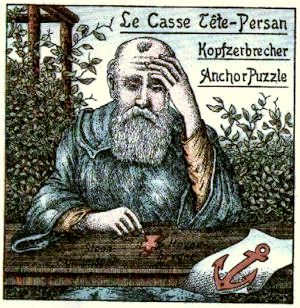
Anker Puzzles
One of the Anker Factory's many activities involved the production of puzzle riddles. A number of stone plates, sometimes wood, usually 7 to 10 pieces, together form a simple geometric shape such as a rectangle, circle or egg shape (Columbus' egg). But by laying them down differently, you can use them to create all kinds of surprising figures. A booklet was provided with some examples - called problems - of those figures, but NOT how to put the puzzle pieces down. That seems very simple, but it is definitely not.

From Slocum en Gebhart, The Anchor Puzzle Book, 2012; the Slocum Puzzle Foundation.
Richter released his first puzzle in 1890, the 7-piece Tangram, which had already been a craze for a while in the early nineteenth century. This new production also became a great commercial success, so 35 others followed. Many riddles sold more than 100,000 copies until well after the First World War. Despite these large numbers, few of them remain today.

The Anker Museum in Berlin
If you really want to feel the stones, see an Anchor building in real life, you might want to visit an Anchor friend among your acquaintances or attend the club meeting once as a guest. But beyond that, you can also visit Dieter Schäfer's Anchor Museum in Spandau (West Berlin) Dieter Schäfer's Anchor Museum in Spandau (West Berlin), open every Tuesday from 10am to 4pm.
Finally
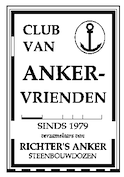
This webpage shows only a limited slice of everything there is to know about Anker stones. In the literature and websites below, you will find a lot more about the history of Ankerstones and what is related to it. You can also get a lot of information from a number of websites. And for a modest annual fee you can also become a member of the 'Club van Ankervrienden' werden.
Literature
- Jörg Bergmann:
Das Bauen, Georgens Steinbaukasten seit 1863
2021, self publication. About the first period after the creation of the stone building boxes - Peter A. Zwijnenberg:
De geschiedenis van Richter's Anker-steenbouwdozen
1982, PAZ Mediacontacten - Annete Noschka:
Gustav Lilienthal 1849 - 1933
1989, contribution from a report of an exhibition at the Landesarchiv in Berlin - J. Stocum & D. Gebhart:
The Anchor Puzzle Book
2012, The Slocum Puzzle Foundation - George F. Hardy:
Richter's Anker (Anchor) Stone Building Sets
2013, self publication - George F. Hardy:
KATALOG der ANKER-BAUSTEINE
July 31, 2013, Club van Ankervrienden
Relevant websites about Anker
- Ankerstein.center
On the web page created by Michael Erhard, you find all historic and very many new building plans (almost 4000), information about all stone sets (800 stone sets), almost all booklets (3800), and the stone catalog of all 2500 different shapes. In addition, you can manage your collection of stones in the ankerstein.center. Further on, here you can also download the actual version of AnkerPlan for free. - Ankerstein.ch
Andrea Mazzocco's website. Includes the complete digitised archive of all Richter designs. -
Anker Steinbaukastenfreunde Berlin
The website of Dieter Schäfer's Berlin Anker Museum. - Ankerwiki.de
Andreas Abel's website. Also new building examples of the most diverse Anker series. - Ankerstein.org
The website of the nestor of the development of knowledge about Anker: George Hardy. No longer maintained. - Anker-bausteine.de
The website of the Anker stone factory where all NF boxes can still be ordered. - Fred
Hartjes-Anker
Fred Hartjes' website about Anker.